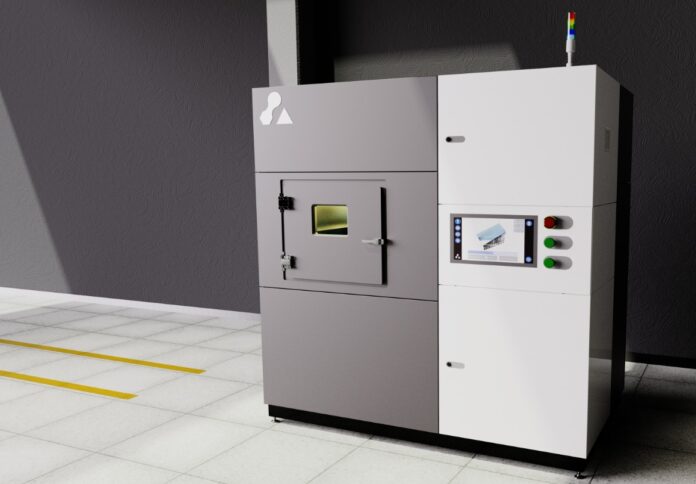It’s been a long time since we haven’t talked about Aurora Labs (A3D), the Australian 3D printer manufacturer developing a Multilevel Concurrent Printing (MCP™) process, a process where multiple layers of powder are laid down at the same time. During the powder laying process, there is an area behind each individual powder gate where printing can take place (operative surface), meaning that printing can occur on these multiple operative surfaces simultaneously (Multilevel Concurrent Printing).
The last time we checked, the company was still on the lookout for its ideal business model. The pandemic came with a restructuring period and since then, the company quietly focused on its activities – and the Australian market.
Until last year.
The company’s primary MCP™ patent has been granted in the USA. The grant completes A3D’s large-format multi-layer printer patent coverage for its MCP™ technology across major global jurisdictions including Australia, China, Japan, Germany, France & Great Britain.
Between a Memorandum of Understanding signed with Aramco – one of the world’s leading integrated energy and chemicals company and a Master Services Agreement (MSA) with Chevron Australia for the provision of Additive Manufacturing services, A3D launched a new metal 3D printer: the AL250 industrial 3D printer.
Key attributes of the new 3D printer
Central to the AL250’s functionality is a powder dosing mechanism, A3D says. Powder is conditioned with heat, prior to being deposited to the recoating system, ensuring optimal temperatures of powders for spreading and densifying when building a powder layer. Powder layer consistency can reduce mechanical defects within parts and ensure a quality repeatable build.
Alongside this functionality, the AL250 also holds a build plate heater capable of 200°C for extra capability in materials research, and strict environmental control processes allow monitoring over the flow and recirculation of gases, temperature and humidity while printing is undergoing in the build chamber.
Lasing power in the AL250 machine is also at the top of its class with a full 1500W per laser available for deployment to lase highly reflective or conductive powders, such as copper. Efficient and optimized process parameters utilizing this power for processing a variety of powder materials will be available to purchase with the machine.
The target market for machines includes both defense, aerospace, oil and gas industries, engineering specialists and OEMs who have libraries of complex parts produced in bespoke production runs. However, Aurora continues to focus on defense as a key vertical industry that will propel its technology.
That being said, solving complex problems with parts through generative design printed in the AL250 will be key to demonstrating the strength and flexibility of the printer to the wider market.
Today
With ongoing application discussions with customers in target markets of defense and aerospace, A3D will be able to fast-track its progression and capabilities of its machines.
One of the customers that will enable them to do so is Chiron Global Tech, an Australian technology company providing advanced training and operational protective equipment to defence and law enforcement customers.
By working with Chiron’s engineering team, A3D will provide 3D printed parts that will be integrated into the Chiron-X1 advanced composites, high impact combatives training suit.
Commenting on activities, CEO Rebekah Letheby, said: “The design for additive manufacture of parts with defense applications has accelerated quickly to a stage where we are now undergoing mechanical testing which is advancing well. We have a strong level of interest in A3D’s printed parts from select defense customers such as Chiron Global Tech.”
The ease at which 3D printing enables design changes to a part to allow for effortless 3D printing is evident in the fact that multiple designs of the same part can be produced in one print and move to testing the following day. Prints can occur in less than a day and therefore rounds of testing can be finished in days rather than weeks. This manner of preparing for serial print production is extremely efficient compared to traditional manufacturing which might use several, slower methods of production.
Production efficiency, the weight of armor components, and mechanical strength are key areas of A3D’s testing focus. These two items are intrinsically embedded in A3D’s additive manufacturing process by optimizing parts which can be lightweighted through design or material selection, but which ensure performance of the required mechanical properties. This will allow the wearer of printed components to withstand the impact force and avoid carrying extra weight, this is an excellent demonstration of where 3D printing can excel.
In parallel, A3D continues to work towards delivery of the first AL250 printer and preliminary design works on the Multi-layer Concurrent Printing (MCP) prototype.
Remember, you can post job opportunities in the AM Industry on 3D ADEPT Media free of charge or look for a job via our job board. Make sure to follow us on our social networks and subscribe to our weekly newsletter : Facebook, Twitter, LinkedIn & Instagram ! If you want to be featured in the next issue of our digital magazine or if you hear a story that needs to be heard, make sure you send it to contact@3dadept.com


